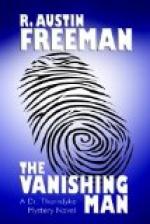“Then, could there be any other purpose with which they agreed better? Yes, there could.
“If it had happened that John Bellingham were known to have worn a ring on that finger, and especially if that ring fitted tightly, the removal of the finger would serve a very useful purpose. It would create an impression that the finger had been removed on account of a ring, to prevent identification; which impression would, in turn, produce a suspicion that the hand was that of John Bellingham. And yet it would not be evidence that could be used to establish identity. Now, if Mr. Jellicoe were the murderer and had the body hidden elsewhere, vague suspicion would be precisely what he would desire, and positive evidence what he would wish to avoid.
“It transpired later that John Bellingham did wear a ring on that finger and that the ring fitted very tightly. Whence it followed that the absence of the finger was an additional point tending to implicate Mr. Jellicoe.
“And now let us briefly review this mass of evidence. You will see that it consists of a multitude of items, each either trivial or speculative. Up to the time of the actual discovery I had not a single crucial fact, nor any clue as to motive. But, slight as the individual points of evidence were, they pointed with impressive unanimity to one person—Mr. Jellicoe. Thus:
“The person who had the opportunity to commit the murder and dispose of the body was Mr. Jellicoe.
“The deceased was last certainly seen alive with Mr. Jellicoe.
“An unidentified human body was delivered to the Museum by Mr. Jellicoe.
“The only person who could have a motive for personating the deceased was Mr. Jellicoe.
“The only known person who could possibly have done so was Mr. Jellicoe.
“One of the two persons who could have had a motive for dropping the scarab was Mr. Jellicoe. The person who found that scarab was Mr. Jellicoe, although, owing to his defective eyesight and his spectacles, he was the most unlikely person of those present to find it.
“The person who was responsible for the execution of the defective will was Mr. Jellicoe.
“Then as to the remains. They were apparently not those of John Bellingham, but parts of a particular kind of body. But the only person who was known to have had such a body in his possession was Mr. Jellicoe.
“The only person who could have had any motive for substituting those remains for the remains of the deceased was Mr. Jellicoe.
“Finally, the person who caused the discovery of those remains at that singularly opportune moment was Mr. Jellicoe.
“This was the sum of the evidence that was in my possession up to the time of the hearing, and, indeed, for some time after, and it was not enough to act upon. But when the case had been heard in Court, it was evident either that the proceedings would be abandoned—which was unlikely—or that there would be new developments.




